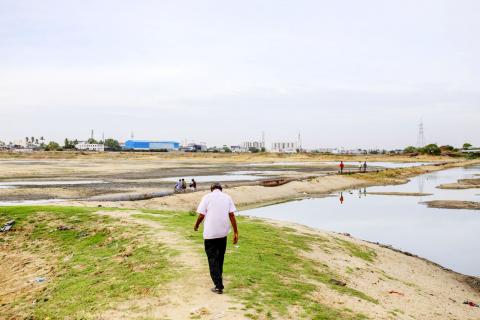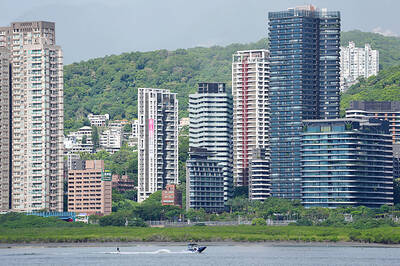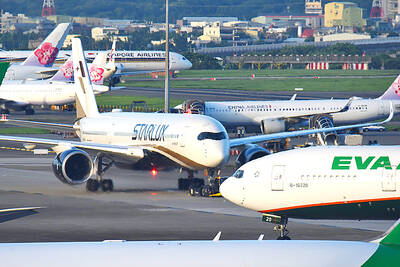India’s steelmakers, more accustomed to securing raw materials such as iron ore and coal, are keeping another key resource in their sights: Water.
Two of India’s biggest steelmakers — JSW Steel Ltd and Tata Steel Ltd — and metal producer Vedanta Ltd have flagged risks due to water shortages in the past month as the world’s second-most populous country faces an unprecedented water crisis, with taps running dry in one of its biggest cities this year.
Competition for the resource is set to grow in India, where nearly one-third of the country is water-stressed, increasing costs and risks for companies. A delayed monsoon, which accounts for 70 percent of the nation’s annual rainfall, has exacerbated the situation this year.

Photo: Bloomberg
“The urgency surrounding water supply risks is not lost in our discussions with companies, but the talking is still happening behind closed doors,” said Damandeep Singh, director at CDP, which runs a global disclosure system for companies and others to report environmental risks. “The problem is that when companies in India get water, they get it cheap. There’s no incentive to manage a resource when it is available so cheap.”
Water is shaping up to be a serious economic risk in Asia’s third-largest economy. Desertification, land degradation and drought cost India about 2.54 percent of GDP in 2014 and 2015, according to a study last year by the Indian Ministry of Environment, Forest and Climate Change.
In a global survey of miners, just under half of the respondents reported a financial impact of US$11.8 billion over five years thanks to water-related problems such as droughts, increased water stress and flooding, according to a CDP report last year.
India’s second-biggest steel mill, JSW Steel, has built a new reservoir with 36.8 million cubic meter storage capacity at its plant in the water-scarce southern state of Karnataka to ensure adequate supply for uninterrupted operations, the Sajjan Jindal-owned company said in its annual report on Thursday last week.
Top producer Tata Steel is also investing in sewage treatment plants to process water for reuse and creating new rainwater harvesting structures to improve the groundwater table. Water is used as a coolant in the steelmaking process and more than 3m3 of fresh water is required per ton (0.9 tonnes) of crude steel produced, it said in the annual report last month.
Billionaire Anil Agarwal’s Vedanta performed a water risk assessment at 25 of its most significant business locations and found that its operations in Rajasthan, Punjab and Tamil Nadu had a greater risk of shortages than elsewhere because of competitive pressures for water usage in those regions, the Mumbai-based company said in its annual report last month.
About 600 million Indians are facing high-to-extreme water stress and the situation is set to worsen as water requirements rise, according to a report last year by NITI Aayog, the Indian government’s policymaking body.
Water demand is expected to be twice the available supply by 2030, implying severe water scarcity for hundreds of millions of people and an about 6 percent loss in India’s GDP, it said.
Greater demand for resources and extraction of mineral reserves in often water-scarce locations, where stable supply of water is no longer guaranteed, continues to jeopardize existing and future operations, CDP said.
“Companies including miners have been taking water for granted for the longest period,” Singh said. “They are still taking an ostrich-in-the-sand approach.”

Taiwan’s rapidly aging population is fueling a sharp increase in homes occupied solely by elderly people, a trend that is reshaping the nation’s housing market and social fabric, real-estate brokers said yesterday. About 850,000 residences were occupied by elderly people in the first quarter, including 655,000 that housed only one resident, the Ministry of the Interior said. The figures have nearly doubled from a decade earlier, Great Home Realty Co (大家房屋) said, as people aged 65 and older now make up 20.8 percent of the population. “The so-called silver tsunami represents more than just a demographic shift — it could fundamentally redefine the

Businesses across the global semiconductor supply chain are bracing themselves for disruptions from an escalating trade war, after China imposed curbs on rare earth mineral exports and the US responded with additional tariffs and restrictions on software sales to the Asian nation. China’s restrictions, the most targeted move yet to limit supplies of rare earth materials, represent the first major attempt by Beijing to exercise long-arm jurisdiction over foreign companies to target the semiconductor industry, threatening to stall the chips powering the artificial intelligence (AI) boom. They prompted US President Donald Trump on Friday to announce that he would impose an additional

China Airlines Ltd (CAL, 中華航空) said it expects peak season effects in the fourth quarter to continue to boost demand for passenger flights and cargo services, after reporting its second-highest-ever September sales on Monday. The carrier said it posted NT$15.88 billion (US$517 million) in consolidated sales last month, trailing only September last year’s NT$16.01 billion. Last month, CAL generated NT$8.77 billion from its passenger flights and NT$5.37 billion from cargo services, it said. In the first nine months of this year, the carrier posted NT$154.93 billion in cumulative sales, up 2.62 percent from a year earlier, marking the second-highest level for the January-September

Asian e-commerce giant Shein’s (希音) decision to set up shop in a historic Parisian department store has ruffled feathers in the fashion capital. Anger has been boiling since Shein announced last week that it would open its first permanent physical store next month at BHV Marais, an iconic building that has stood across from Paris City Hall since 1856. The move prompted some French brands to announce they would leave BHV Marais, but the department store had already been losing tenants over late payments. Aime cosmetics line cofounder Mathilde Lacombe, whose brand was among those that decided to leave following